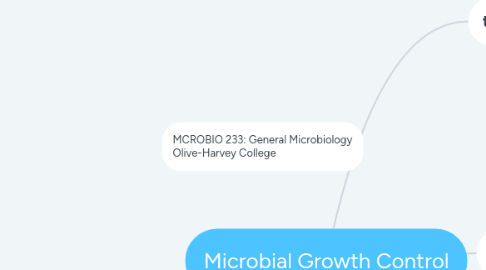
1. MCROBIO 233: General Microbiology Olive-Harvey College
2. physical methods
2.1. high temperatures
2.1.1. incineration (burning)
2.1.2. boiling
2.1.3. autoclaving (high pressure)
2.1.4. dry heat
2.2. pasteurization
2.3. irradiation (usually with UV light)
2.4. filtration
3. chemical methods
3.1. antiseptics
3.1.1. used on skin
3.2. disinfectants
3.2.1. used on inanimate objects/surfaces
3.3. preservatives
3.3.1. used in foods
3.3.1.1. salt
3.3.1.1.1. creates hypertonic environment
3.3.1.2. sugar
3.3.1.2.1. creates hypertonic environment
3.4. antimicrobial drugs
3.4.1. antibiotics
3.4.1.1. most often for bacteria
3.4.1.2. can be natural or synthetic
3.4.1.3. spectrum of action
3.4.1.3.1. broad spectrum
3.4.1.3.2. narrow spectrum
3.4.1.3.3. limited spectrum
3.4.1.4. mechanisms of action
3.4.1.4.1. inhibit transcription
3.4.1.4.2. inhibit translation
3.4.1.4.3. inhibit enzymes
3.4.1.4.4. disruptions of plasma membrane
3.4.1.4.5. inihibit cell wall synthesis (target = peptidoglycan)
3.4.1.4.6. inhibit DNA replication
3.4.2. antifungals
3.4.2.1. disruption of plasma membranes (target = ergosterol, animal cells have cholesterol )
3.4.2.2. inhibition of cell wall synthesis (target = chitin)
3.4.3. antiparasitics
3.4.3.1. antiprotozoans
3.4.3.2. antihelminthics
3.4.3.3. anti-ectoparasites / parasitic arthropods
3.4.4. antivirals
3.4.5. Questions
3.4.5.1. Which of these drug types would generally be the least toxic to humans?
3.4.5.1.1. Why?
3.4.5.2. Which of these drug types would generally be the most toxic to humans?
3.4.5.2.1. antiparasitics
4. terminology
4.1. -cidal vs. -static
4.1.1. -cidal means a method that kills microbes
4.1.2. -static means inhibition of growth
4.2. sterile vs. aseptic
4.2.1. sterile means elimination of all microbes
4.2.2. aseptic means reduction in microbes
